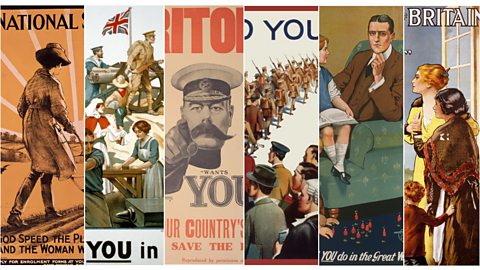How men’s jobs helped on the front line
Many men who went to war were able to use the skills learned from their jobs at home.
Men who worked with horses were useful recruits as the Army had thousands of horses.
Men who knew how to drive could transport supplies in buses and lorries. Or even drive a tank!
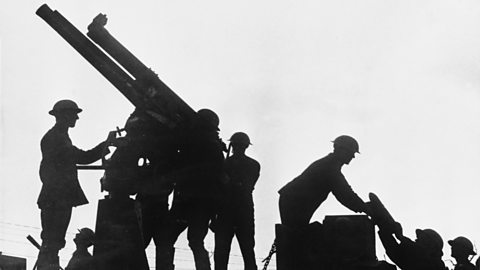
Coal miners became 'sappers', experts at tunnels and trenches.
The rifle was the soldier's main weapon. Men who knew about rifles were highly valued.
Artillery soldiers, known as ‘gunners’, fired explosive shells. The biggest guns weighed several tons and were hard to move. Artillery guns would fire thousands of shells to flatten enemy defences before the infantry ran forward. This was known as a barrage.
What were the different types of soldiers?
Most soldiers in the Army were in the infantry. They were foot soldiers, trained to march and carry all their equipment.
A soldier had to be dressed at all times with his rifle ready.

Image caption, Infantry soldiers lived in trenches for up to weeks at a time
When an attack was ordered, lines of infantry soldiers climbed out of the trenches and marched towards the enemy. This was called 'going over the top'.
Image caption, Soldiers were given a rank, most were privates at the start
Some moved up to become corporals, sergeants and officers. The higher the rank, the more responsibility. Rank was distinguished by stripes and badges worn on the cuff their coat.
Image caption, Sappers planned where trenches should be dug, miners dug tunnels
Their jobs were very dangerous because the tunnels could collapse or the mines they were carrying could explode. Because of their work underground miners were sometimes called 'moles'.
1 of 3
What kinds of jobs did sailors do?
In 1914 Britain had the biggest and strongest navy in the world.
The Royal Navy had hundreds of ships and more than 200,000 sailors.
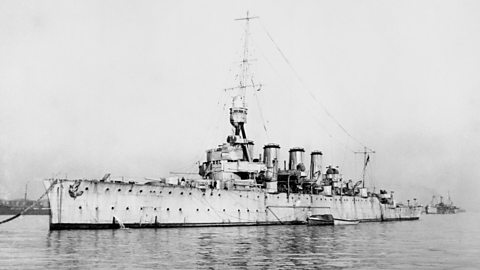
Image caption, The Navy protected the British Isles and its colonies
It also blockaded the ports of enemy countries to stop supplies getting in. World War One saw only one really big sea battle, the Battle of Jutland in 1916.
Image caption, There were many different jobs for sailors on board ships
Stokers supplied the engines with coal; Armourers looked after guns and shells; Stewards served officers and the Captain; and Buglers used music to signal messages or warnings.
Image caption, Able Seamen had at least two years of experience at sea
Men with less experience were called Landsmen or Ordinary Seamen. There would also be Engineers to look after the ship engines and a Captain to command the ship.
Image caption, Submarines had smaller crews but could destroy warships
Living and working space was very small. Sometimes men would be living under the sea for months at a time. The crew worked in shifts, 24 hours a day to ensure the submarine worked well.
1 of 4
What different jobs were there in the Air Force?
Using aircraft in war was a new idea. Pilots first belonged to the Army's Royal Flying Corps or the Royal Naval Air Service.
These joined forces in 1918 to become the Royal Air Force.
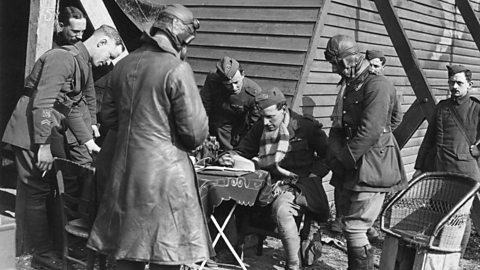
Image caption, Pilots handed in reports after flying over enemy lines
Their thick coats, gloves and helmets kept them warm when sitting in open cockpits in their planes.
Image caption, Pilots flew in aircraft made of wood, wire and cloth
They had no parachutes. At that time parachutes were very heavy and it was feared they would stop aircraft being able to take off!
Image caption, Battles were known as 'dogfights' and top fighter pilots were 'aces'
The British Distinguished Flying Cross was for pilots who shot down at least eight enemy planes, such as the German Gotha plane in this picture.
Image caption, Flying was extremely difficult and dangerous
The pilot had to dodge other enemy aircraft while listening to the gunner telling him where to fly. Their planes flew slowly and sometimes crashed.
1 of 4
Watch: Men's jobs at home
Watch our video to find out more about how men’s jobs back home could prepare them for life at war.
[MUSIC]
[APPLAUSE]
ALBERT GURNEY: ‘Ello. This war has messed up everyone’s business including mine.
Pleased to meet you. I’m Albert Gurney and I manage this theatre here, the Empire.
Here I am talking to a constable.
CONSTABLE: I’m sorry Mr Gurney but you’ll have to switch off the lights.
ALBERT GURNEY: But how are people meant to read the play bills?
CONSTABLE: Sorry sir, it’s the rules. A blackout.
ALBERT GURNEY: Surely the Zeppelins won’t come this far. Constable, this theatre’s my livelihood!
CONSTABLE: It’s your liveliness which is my concern sir. Switch ‘em off.
ALBERT GURNEY: Oh alright.
[MUSIC PLAYS]
[APPLAUSE]
SOLDIER: Don’t take it from me, take it from them.
MICKEY MICHAELS: I’m Mickey Michaels. I was a rag -and-bone man picking through scraps to earn a living.
Now I drive ambulances working with horses again. Brave animals. Most of the time, braver than me.
But together we save lives.
There’s no more worthwhile thing a man can do. Sign up!
[APPLAUSE]
JACK MCCLAIN: I’m Jack McClain. I was your coal man.
AUDIENCE MEMBER: Didn’t recognise you with your face washed!
[LAUGHTER]
JACK MCCLAIN: Now I shovel coal into the engines of war ships.
There’s German submarines sinking all our ships.
Ships bringing our children food. I protect these ships. My job still is dirty but I don’t complain about the cold now.
[APPLAUSE]
JIM JARMAN: I’m Jim Jarman. I was a gameskeeper for the big estate.
I used to shoot ducks out the sky. Good shot I was too.
Now I shoot planes out of the sky.
Battles don’t just take place on the land or the sea but amongst the clouds with the wind on your face. Join up!
[APPLAUSE]
SOLDIER: Enough talk. It’s time to act. Prove you do your bit. Join us.
ALBERT GURNEY: You heard him. So while you get up and sign up, ladies and gentleman, Miss Vista Tilley!
[APPLAUSE]
Looks like Vista won’t be the only one bringing the house down tonight.
[EXPLOSIONS RUMBLE IN THE DISTANCE]
How did the war change men’s lives?
Despite the many volunteers who joined the armed forces, there was still a shortage by 1916.
A law was passed forcing men to join up, called conscription.
By 1918 all men under 51 were being called up.
Lots of men did not want to go to war, but they had to go. Many had never left their home town or village before. Soon they were in the thick of battles.

Activities
Activity 1: Quiz – Men on the front line
Activity 2: History Explorer game
Play this game to test your knowledge and learn even more facts about World War One.
History Explorer: Secrets through time
History Explorer: Secrets through time: KS2 History
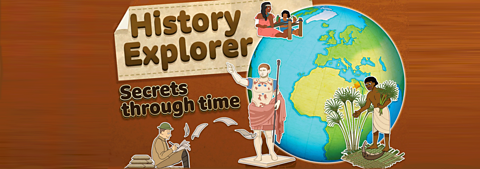
Bitesize Primary games. gameBitesize Primary games
Play fun and educational primary games in science, maths, English, history, geography, art, computing and modern languages.

More on World War One
Find out more by working through a topic
- count8 of 43
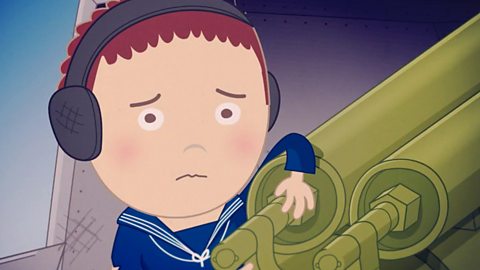
- count10 of 43
